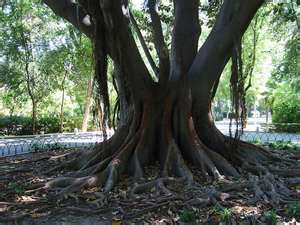 |
| Time to start the walking tour! |
By noon all of us were on the bus eager to see the great sites of the beautiful city of Seville. We joined a convoy of large tour buses that were parked near the Maria Louisa Park. The gardens were a gift to the city by the duchess, Maria Luisa Fernanda de Bourbon in 1893. In 1929 the park was redesigned and became the center piece of the Hispanic-American Exhibition. This Exhibition was initiated in 1909 intended to lift Seville out of a period of economic stagnation through a program of public works while encouraging tourism. The French landscaper Jean-Claude Nicolas Forestier was hired to do the plan. It is no wonder that so much of the garden has the French influence of trimmed hedges and meticulously organized formal flower beds. The park also boasts a collection of botanical species and a huge, old fig tree.
We left the bus and walked toward the Plaza de Espana. The grounds of the garden and exhibition are huge and many buildings have been added, but the tour guide felt since we were limited by time, we should at least see the center piece of the area. The Plaza was bordered by beautiful blue row of Jacaranda trees. The building was designed by the Spanish Architect Anibal Gonzales who unfortunately died before the exhibition opened in 1929. It took more than a thousand workmen to construct the neo-Renaissance Pavillion from 1914 to 1928 to build the 262 foot towers and the 656 diameter. The semicircular stucture consists of an arcade gallery overlooking a series of ceramic designs dedicated to the Spanish provinces. It also has a 500 yard long canal which follows the curve of the plaza and in the center there is a beautiful fountain.
Many of us checked out the beautiful ceramic designs of the provinces.
Several of us walked over the bridge that spanned the canal.
From M. Jensen
 We left the Plaza de Espana and headed toward the Alcazar. We had to travel through narrow streets of the Jewish quarter. Jews migrated to Seville around the 4th century and flourished under the Visigoths and the Muslims. When the Christians invaded they expelled the Jews and Muslims and make their synagogues and mosques into Catholic Churches. The Jews returned to Seville under Ferdinand III and Alfonso X. They were given the area to the north of the Alcazar: 40 acres of buildings surrounded by a wall. During the reign of Pedro I the Jewish community numbered some two thousand people and was represented by a class of affluent financiers in the service of the Crown. But in 1391 a riot brought about their downfall: the sermons of Archdeacon Ferran Martinez incensed the population and precipitated an attack on the Jewish quarter which left many dead and led to enforced conversions and exiles.
We left the Plaza de Espana and headed toward the Alcazar. We had to travel through narrow streets of the Jewish quarter. Jews migrated to Seville around the 4th century and flourished under the Visigoths and the Muslims. When the Christians invaded they expelled the Jews and Muslims and make their synagogues and mosques into Catholic Churches. The Jews returned to Seville under Ferdinand III and Alfonso X. They were given the area to the north of the Alcazar: 40 acres of buildings surrounded by a wall. During the reign of Pedro I the Jewish community numbered some two thousand people and was represented by a class of affluent financiers in the service of the Crown. But in 1391 a riot brought about their downfall: the sermons of Archdeacon Ferran Martinez incensed the population and precipitated an attack on the Jewish quarter which left many dead and led to enforced conversions and exiles.We continued walking past open plazas where people sat enjoying a noon time meal, and by street musicians hoping for a contribution form the tourists.
We continued our walk until we got to the Reales Alcazares, a true historic jewel! It was handed down by the first caliphs to their successors and when the Catholic monarchs invaded, they must have been blown away by the beauty of the architecture, ornamental gardens, pavilions, fountains, pools and wide variety of plants. We waited eagerly in line to feast our eyes on the beauty that was to come.
The Alcazar is a vast fortified area of many palaces, gardens and outer buildings. It has distinguished itself from other royal palaces belonging to the Spanish Crown by the originality of its architecture. It was designed and built by Moorish workers brought in from Granada. Moorish influences combined with Gothic, Renaisance and Baroque elements give it a unique charm. We entered the plaza the courtyard surrounded by the intricate designs of the walls and doors. The guide then led us into each room and pointed out the oldest part, Sala de Justicia (The Hall of Justice), the Patio de Yeso, (Courtyard of Plaster) and the Salon de Embajadores (Hall of he Ambassadors) with its cedar cupola of green, red, and gold.
 |
| Picture by Mary Anne Jensen |
The beauty was all around but our feet needed a break, so some of us found a bench to take a breather!
After a rest, we were up again to explore the gardens. Besides small gardens between buildings a much larger garden meticulously organized evolved within the walls of the Alcazar. It would be very easy to get lost for days if our group ventured through this area especially if any of us ventured through the Labyrinth made of manicured hedges. So we were content to walk around a confined area taking pictures in the Fountain of Troy.

























No comments:
Post a Comment